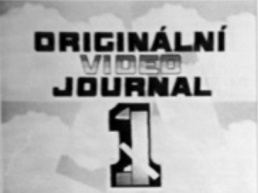Difference between revisions of "Original Videojournal"
| Line 1: | Line 1: | ||
| − | '''Originální Videojournal''' was a dissident video magazine started from [[Václav Havel|Václav]] and Olga Havel | + | [[Image:Original_Video_Journal_1_still.jpg|thumb|258px|]] |
| + | '''Originální Videojournal''' [Original Videojournal] was a dissident video magazine which started from the initiative of [[Václav Havel|Václav]] and Olga Havel. It was being edited and copied secretly on school equipment. Seven regular and two thematic programmes were produced between Autumn 1987 and November 1989, followed by nine special volumes made during and shortly after the 1989 revolution. | ||
| − | + | In the late 1987, an idea was born to not only send the video shots documenting the Czechoslovak dissident activities abroad, but also to produce a programme for the domestic audience. With the financial aid from the Czech exile centers abroad (Foundation of Charter 77, ČSDS – Czechoslovak Documentary Centre), the “Original Videojournal” editorial group acquired a video tape recorder Sony Video-8. This led to the production of video news from the dissident and alternative culture, covering political and ecological issues from the “unofficial” perspective. | |
| + | |||
| + | Core editorial group included Olga Havlová (editor, photographer), Michal Hýbek (cameraman, video editor, editor, distribution), Pavel Kačírek (editor-in-chief, cameraman, video editor), Jan Kašpar (cameraman, editor), Andrej Krob (cameraman, editor), Jan Ruml (editor responsible for the political section), Joska Skalník (editor responsible for the cultural section), and Andrej Stankovič (editor). Collaborators included Jarmila Bělíková, Přemysl Fialka, Aleš Havlíček, Jiří Kantůrek, Jaroslav Kořán, Jaroslav Kukal, Milan Maryška, Petr Oslzlý, Jiří Reichl, Jiří Mergl, David Schmoranz, as well as Karel Freund, František Janouch, Vilém Prečan, Jiřina Šiklová, and Pavel Tigrid. (Růžičková:2000, pp 10-11) | ||
| + | |||
| + | ==See also== | ||
* [[Czech Republic#Video art]] | * [[Czech Republic#Video art]] | ||
| − | + | == Literature== | |
| − | * Alice Růžičková, ''[[Media:Ruzickova_Alice_Cesky_dokumentarni_film_v_80_letech_Originalni_Videojournal.pdf|Český dokumentární film v 80. letech: "Originální Videjournal"]]'', Prague: FAMU, 2000. Master thesis. (in Czech) | + | * Alice Růžičková, ''[[Media:Ruzickova_Alice_Cesky_dokumentarni_film_v_80_letech_Originalni_Videojournal.pdf|Český dokumentární film v 80. letech: "Originální Videjournal"]]'', Prague: FAMU, 2000. Master thesis. (in Czech) [http://monoskop.org/log/?p=8839] |
* Alice Růžičková, "Originální Videojournal", in ''Alternativní kultura'', edited by Josef Alan, Jihlava: Nakladatelství Lidové noviny, 2001, pp 474-491. (in Czech) | * Alice Růžičková, "Originální Videojournal", in ''Alternativní kultura'', edited by Josef Alan, Jihlava: Nakladatelství Lidové noviny, 2001, pp 474-491. (in Czech) | ||
* Alice Lovejoy, "[http://books.google.com/books?id=fVJFAAAAQBAJ&pg=PA206 'Video Knows No Borders': Samizdat Television and the Unofficial Public Sphere in 'Normalized' Czechoslovakia]", in ''Samizdat, Tamizdat & Beyond: Transnational Media During and After Socialism'', edited by Friederike Kind-Kovács and Jessie Labov, Berghahn Books, 2013, pp 206-220. | * Alice Lovejoy, "[http://books.google.com/books?id=fVJFAAAAQBAJ&pg=PA206 'Video Knows No Borders': Samizdat Television and the Unofficial Public Sphere in 'Normalized' Czechoslovakia]", in ''Samizdat, Tamizdat & Beyond: Transnational Media During and After Socialism'', edited by Friederike Kind-Kovács and Jessie Labov, Berghahn Books, 2013, pp 206-220. | ||
[[Category:Video activism]] | [[Category:Video activism]] | ||
Revision as of 18:04, 15 August 2013
Originální Videojournal [Original Videojournal] was a dissident video magazine which started from the initiative of Václav and Olga Havel. It was being edited and copied secretly on school equipment. Seven regular and two thematic programmes were produced between Autumn 1987 and November 1989, followed by nine special volumes made during and shortly after the 1989 revolution.
In the late 1987, an idea was born to not only send the video shots documenting the Czechoslovak dissident activities abroad, but also to produce a programme for the domestic audience. With the financial aid from the Czech exile centers abroad (Foundation of Charter 77, ČSDS – Czechoslovak Documentary Centre), the “Original Videojournal” editorial group acquired a video tape recorder Sony Video-8. This led to the production of video news from the dissident and alternative culture, covering political and ecological issues from the “unofficial” perspective.
Core editorial group included Olga Havlová (editor, photographer), Michal Hýbek (cameraman, video editor, editor, distribution), Pavel Kačírek (editor-in-chief, cameraman, video editor), Jan Kašpar (cameraman, editor), Andrej Krob (cameraman, editor), Jan Ruml (editor responsible for the political section), Joska Skalník (editor responsible for the cultural section), and Andrej Stankovič (editor). Collaborators included Jarmila Bělíková, Přemysl Fialka, Aleš Havlíček, Jiří Kantůrek, Jaroslav Kořán, Jaroslav Kukal, Milan Maryška, Petr Oslzlý, Jiří Reichl, Jiří Mergl, David Schmoranz, as well as Karel Freund, František Janouch, Vilém Prečan, Jiřina Šiklová, and Pavel Tigrid. (Růžičková:2000, pp 10-11)
See also
Literature
- Alice Růžičková, Český dokumentární film v 80. letech: "Originální Videjournal", Prague: FAMU, 2000. Master thesis. (in Czech) [1]
- Alice Růžičková, "Originální Videojournal", in Alternativní kultura, edited by Josef Alan, Jihlava: Nakladatelství Lidové noviny, 2001, pp 474-491. (in Czech)
- Alice Lovejoy, "'Video Knows No Borders': Samizdat Television and the Unofficial Public Sphere in 'Normalized' Czechoslovakia", in Samizdat, Tamizdat & Beyond: Transnational Media During and After Socialism, edited by Friederike Kind-Kovács and Jessie Labov, Berghahn Books, 2013, pp 206-220.
